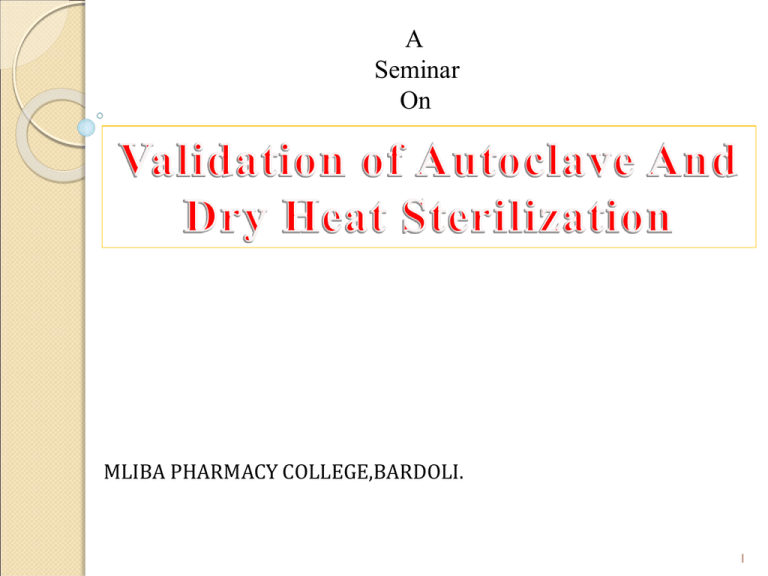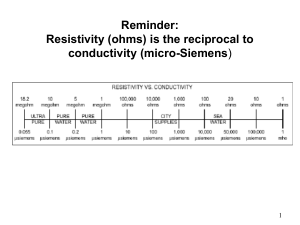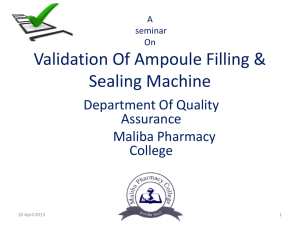Validation
advertisement

A Seminar On MLIBA PHARMACY COLLEGE,BARDOLI. 1 Contents Introduction to Validation Stages of qualifications Validation of Autoclave Validation Protocol of Autoclave Validation of Dry Heat Sterilizers And Tunnel Validation Validation may be defined as ” Establishing documented evidence which provides a high degree of assurance that a specific process meeting its will consistently produce a product pre-determined specifications and quality attributes.” It has been made mandatory by the regulatory bodies to prove the safety efficacy, Purity & effectiveness of the drug product, medical devices & biologics in the marketplace & health system. Why Validation of Equipment? Equipment validation is Vital for Safety Fewer interruptions of work Lower repair costs Elimination of premature replacement Less standby equipment Identification of high maintenance cost Reduction of variation in results Greater confidence in the reliability of results Who should do Equipment Validation? The vendor or the user The user has the ultimate responsibility for the accuracy of the analysis results and also for equipment qualification. DQ should always be done by the user. While IQ for a small and low cost instrument is usually done by the user, IQ for large, complex and high cost instruments should be done by the vendor. OQ can be done by either the user or the vendor. PQ should always be done by the user because it is very application specific, and the vendor may not be familiar with these. As PQ should be done on a daily basis, this practically limits this task to the user. Validation Part 1. Overview on qualification and validation Part 2. Qualification of HVAC and water systems Part 3. Cleaning validation Part 4. Analytical method validation Part 5. Computerized system validation Part 6. Qualification of systems and equipment Part 7. Non sterile product process validation Validation Stages of qualification Design qualification Installation qualification Operational qualification Performance qualification Change control Validation Defined schedule Frequency based on Factors Results of calibration maintenance, verification Periodic Requalification After change Extent based on Risk assessment Part of Change control procedure Equipment qualification Equipment qualification / validation includes following things: Design qualification (DQ) Installation qualification (IQ) Operational qualification (OQ) Performance qualification (PQ) Design Qualification (DQ) "Design qualification (DQ) defines the functional and operational specifications of the instrument and details for the conscious decisions in the selection of the supplier". List below recommends steps that should be considered for inclusion in a design qualification. Description of the analysis problem Description of the intended use of the equipment Description of the intended environment Preliminary selection of the functional and performance specifications Preliminary selection of the supplier Instrument tests (if the technique is new) Final selection of the equipment Final selection of the supplier and equipment Development and documentation of final functional and operational specifications Installation Qualification(IQ) “Installation qualification establishes that the instrument is received as designed and specified, that it is properly installed in the selected environment, and that this environment is suitable for the operation and use of the instrument.” The qualification involves the coordinated efforts of – The vendor The operating department The project team (which provide input into the purchase, installation, operation and maintenance of the equipment). Operational Qualification (OQ) "Operational qualification (OQ) is the process of demonstrating that an instrument will function according to its operational specification in the selected environment." The proper operation of equipment is verified by performing the test functions specified in the protocol. A conclusion is drawn regarding the operation of equipment after the test functions are checked and all data has been analyzed. Following are the contents of equipment operation qualification 1.Application S.O.P’s 2.Utilization List 3.Process Description 4.Test Instrument Utilized To Conduct Test 5.Test Instrument Calibration 6.Critical Parameters 7.Test Function (List) 8.Test Function Summaries Performance Qualification(PQ) "Performance Qualification (PQ) is the process of demonstrating that an instrument consistently performs according to a specification appropriate for its routine use ". PQ should always be performed under conditions that are similar to routine sample analysis. PQ should be performed on a daily basis or whenever the equipment is being used. In practice, PQ can mean system suitability testing, where critical key system performance characteristics are measured and compared with documented. A. Introduction Sterile products have several unique dosage form properties, such as Freedom from micro-organisms, Freedom from pyrogens, Freedom from particulates, Extremely high standards of purity and quality; However, the ultimate goal in the manufacture of a sterile product is absolute absence of microbial contamination. Introduction(Con..) Three principles are involved in the validation process for sterile product. 1. To build sterility into a product 2. To demonstrate to a certain maximum level of probability that the processing and sterilization methods have established sterility to all units of a product batch 3. To provide greater assurance and support of the results of the end product sterility test D value “It is time required for a 90% reduction in microbial population. Quantitative expression of rate of killing of micro organism.” In other words, the D value will be affected by The type of microorganism used as BI, The formulation components and characteristics The surface on which the micro-organism is exposed The temperature, gas concentration, or radiation dose of sterilization process. D value found by 2 methods, 1) Survivor curve method (log number of surviving organism versus time/gas concentration/radiation dose) 2) Fraction negative method Z value Used exclusively in validation of heat sterilization process. Z value is reciprocal of slope of plot of log D verses T at which D value is found i.e. increase in temperature required to reduce D value of organism by 90 % (1 log reduction) F value Used exclusively in validation of heat sterilization process. It is time in min required to kill all spores in suspension at 121oC. Measures equivalent time Methods of Sterilization of Products 1.Heat Moist heat (autoclave) Dry heat oven or tunnel 2.Gas Ethylene oxide Peracetic acid Vapor phase hydrogen peroxide Chlorine dioxide 3.Radiation Gamma Beta Ultraviolet B. Qualification and Calibration 1) Mechanically Checking, Upgrading, and Qualifying the Sterilizer Unit The main concern with steam sterilization is the complete removal of air from the chamber and replacement with saturated steam. Autoclaves can also involve air–steam mixtures for Sterilizing flexible packaging systems and syringes. When autoclave system is used, the unit must be installed properly and all operations qualified through installation qualification and operation qualification (IQ/OQ). 2) Selection and Calibration of Thermocouples Thermocouples must be durable for repeated use as temperature indicators in steam sterilization validation and monitoring. Copper constantan wires coated with Teflon are a popular choice as thermocouple monitors. Accuracy of thermocouples should be 0.5°C. Temperature accuracy is especially important in steam sterilization validation. Thermocouple accuracy is determined using National Bureau of Standards (NBS). 3) Selection and Calibration of BI Sr. No Sterilization process Biological Indicator(BI) 1. Autoclave B. steriothermophillus spores B. subtilis var. niger spores B. subtilis, 5230 spores B. coagulance spores Clostridium sporogenes spores 2. Dry heat B. subtilis var. niger spores B. subtilis, 5230 spores 3. Ethylene Oxide B. subtilis var. niger spores 4. Radiation B. pumilus spores Micrococcus radiodurans vegetative cells C. Heat-Distribution Studies Heat-distribution studies include two phases: 1) Heat distribution in an empty autoclave chamber 2) Heat distribution in a loaded autoclave chamber. The trips where the wires are soldered should not make contact with the autoclave interior walls or any metal surface. Cont.. Heat-distribution studies may employ thermocouples as the cool spot in the chamber. The principle is the location of the cool spot and the effect of the load size and/or configuration on the cool spot location. The difference in temperature between the coolest spot and the mean chamber temperature should be not greater than • 2.5°C . Greater temperature differences may be indicative of equipment malfunction. D. Heat-Penetration Studies This is the most critical component of the entire validation process. The main purpose is to determine the F0 value of the cold spot inside the commodity. The container cold spot for containers ≥100 ml is determined using container-mapping studies. Thermocouple probes are inserted within a container and repeat cycles are run to establish the point inside the container. Cont.. Thermocouples will be placed both inside and outside the container at the cool spot location(s), in the steam exhaust line, and in constanttemperature baths outside the chamber. F0 value will be calculated based on the temperature recorded by the thermocouple inside the container at the coolest area of the load. F0 value will indicate whether the cycle is adequate or alterations are needed. Heat-Penetration Studies(Con..) Three critical parameter associated with all wet heat sterilization Processes: 1. A minimum F value 2. A design F value 3. A sterilization process time Any changes in the load size, load configuration, or container characteristics must be accompanied; To prove that the cool spot location has not changed or, If it has, that it receives the design F0 time exposure from the sterilization cycle used. E. Equipment Qualification Prior to the initiation of process, it is important that the sterilizer be suitably qualified to perform its function. Typical critical requirements that are considered to affect the sterilization process (e.g.“quality” requirements) are: Accurate temperature and pressure measurement Air removal to some predefined level of vacuum Temperature chamber. distribution and uniformity in the The qualification of a sterilizer should include the following : 1.Calibration of temperature and pressure sensors (traceable to national or international standard) 2.Air removal (usually measured by vacuum level achieved vs. defined requirement) 3.Demonstration of the sequence of operations, 4.Confirmation of alarms and interlocks 5.Precision of temperature control 6.Temperature distribution and uniformity F. Microbiological Challenge Studies Microbiological challenges studies are employed to provide additional necessary assurance that adequate lethality has been delivered to all parts of the load. Calibrated BIs used as bioburden models providing data that can be employed to calculate Fo. The microorganisms used to challenge moist heat sterilization cycles are G. stearothermophilus and Clostridium sporogenes. After the sterilization cycle is complete, the inoculated items or spore strips are recovered and subjected to microbiological test procedures. Strips are immersed in a suitable growth medium (soybean casein digest medium is typical) and incubated for up to seven days. G. Sterilizer Filter Evaluation Microbial filters are employed on most parts of sterilizers to ensure that loads are not contaminated by air used to vent the chamber as it cools or dries. Product loads are protected from such contamination by their primary containers (vials, bags) and many nonproduct loads are protected by wraps to provide a microbial barrier. For filters, two issues are of concern: Sterility and Integrity. If the load will undergo a bioburden cycle, it may be necessary to sterilize the filter in a separate phase of the cycle. To ensure that filters will remain functional under all expected conditions, the integrity tests should be done following the maximum cycle time and temperature. Triplicate studies are recommended. A. Introduction Mainly three types of dry-heat sterilization systems are utilized in the pharmaceutical industry today. I. Batch Sterilizer Ovens II. Tunnel Sterilizers III. Microwave Sterilizers PRINCIPLES OF HEAT TRANSFER AND CIRCULATION: The dry heat process must effectively heat the article, and air surrounding the article, to achieve sterilization or depyrogenation. In moist heat, the condensation of the steam sterilizer releases large amounts of heat energy that serves to heat the items in the sterilizer. In dry heat processes the hot air carries significantly less heat energy than an equivalent volume of saturated steam. Key Process Features to Control Prior to Validating Dry-Heat Sterilizer Batch(Oven) Tunnel Steriliser Intake air system Positive pressure to entrance Exhaust air system Even distribution of heat Internal air circulation Belt speed recorder Exhaust HEPA filter HEPA-filtered cooling air Static pressure gauge Exhaust HEPA filter Heater current Particulate control The four main mechanism through which Heat transfer occurs are: Convection Circulation Conduction Radiation B. Batch Oven Validation 1. Air balance determination: In an empty oven, data are obtained on the flow rates of both intake and exhaust air. Air should be balanced so that positive pressure is exerted to the nonsterile side when the door is opened 2. Heat distribution of an empty chamber: Thermocouples should be situated according to a specific predetermined pattern. Repeatability of temperature attainment and identification of the cold spot can be achieved if the temperature range is • 15°C at all monitored locations. 3. Heat-penetration studies: These studies should be designed to determine the location of the slowest heating point within a commodity at various locations of a test load in the sterilizer. Thermocouples are placed in the commodities located in the areas likely to present the greatest resistance to reaching the desired temperature. Minimum and maximum temperatures as defined in the process specifications should be studied. 4. Mechanical repeatability: During all repeatability these in studies, terms of mechanical air velocity, temperature consistency, and reliability and sensitivity of all the oven and instrumental controls must be verified. C. Tunnel Sterilizer Validation 1. Air Balance Determination: In this study items being sterilized are moving exposed to different air systems (e.g., heating zone and cooling zone). Air flow must be balanced in order to provide a gradual decrease in air temperature as items move along the conveyor. In the absence of a critical balance of air dynamics, either the items will not be cooled or they will be cooled too quickly, causing contamination of the entire tunnel area. 2. Heat-Distribution Studies: Thermocouples used in tunnel sterilizer validation must be sufficiently durable to withstand the extremely high (≥300°C) temperatures in the heating zone area of the tunnel. Heat-distribution studies should determine where the cold spots are located as a function of the width of the belt and height of the tunnel chamber. Peak temperature readings should remain within • 10°C across the belt for at least three replicate runs. 3. Heat-Penetration Studies: Prior to microbial challenge testing of the tunnel sterilization, heat-penetration studies must be completed in order to identify the coolest container in the entire load. Three to five replicate runs for each commodity size and every loading configuration should be done using 10 to 20 thermocouples distributed throughout the load. Careful analysis of the temperature data after each run will be invaluable in the determination of the cool spot 4. Mechanical Repeatability: Tunnel sterilizers must demonstrate mechanical repeatability in the same manner as batch ovens. Air velocity, air particulates, temperature consistency and reliability of all the tunnel controls (heat zone temperatures, belt speed) must be proved during the physical validation studies. D. Biological Process Validation of Dry Heat Sterilization Cycles If the dry-heat process is claimed to produce both sterile and pyrogen-free commodities, validation studies must be done using both micro-organisms and microbial endotoxins. The goal is to validate a heating cycle that can produce a 12-log reduction in the biological indicator population. The most widely used biological indicators for dry heat have been spores of B. Subtilis. Procedures for the validation of a tunnel sterilization: The overkill approach is selected for the validation study. Select Run the type of biological indicator to be used. a complete cycle using the desired loading pattern. Determine the number of survivors by plate-counting or fraction negative Methods. Determine the number of spore log reductions (SLRs) E. Endotoxin challenge in Dry Heat Sterilization Inoculate commodity samples with a known amount of endotoxin. (e.g., 10–100 ng Escherichia coli lipopolysaccharide) Thermocouples adjacent to should be placed in commodities those containing endotoxin for temperature monitoring and correlation with LAL test results. Endotoxin destruction should be ascertained at the coolest location of the load. Several endotoxin challenge samples should be done per cycle, and the studies must be adequately replicated. Following the dry-heat cycle, aseptically transfer the units containing endotoxin to an aseptic area for extraction procedures. F values required for endotoxin destruction at various temperatures and/or cycle time– temperature variations can be determined using a Z value of 54°C. VALIDATION OF TEST EQUIPMENT Equipment required to conduct the IQ, OQ and PQ are discussed here. All temperature equipment employed to perform the validation studies must be traceable and calibrated to the International Temperature Scale The equipments used for validation testing of dry heat processes are discussed here: Resistance Temperature Detectors Thermocouples Data Loggers Wireless Temperature Logger Infrared Thermometer Constant Temperature Stopwatch Voltmeter or Ammeter Optical Tachometer Baths INSTALLATION QUALIFICATION The IQ is designed to compare the system against the manufacturer’s specifications for proper installation. All equipment, utilities, and connections must be checked against the manufacturer’s recommendations. A. Structural: Check dimensions, presence of identification plates, correct leveling, proper insulation, presence of seals, and inspect for structural damage. B. Filters: All filters used within the system must be recorded, such as those used with air (supply, recirculating) or in other utilities (e.g., steam, water). Some HEPA filters may need to be checked periodically by performing an integrity test or DOP. C. Electrical: Ensure conformance to National Electrical Code Standards D. HVAC: Ensure the system provides the RH, temperature, and pressure differential required. E. Air Supply: Identify source (direct from the HVAC system or room air), duct size, duct material of construction, and air classification. F. Ventilation: Check that the ventilation exhaust duct exhausts to an appropriate area (not to an aseptic environment), and identify the method used to prevent back-flow. G. Door Gaskets: Check integrity of gaskets and materials of construction. H. Heaters: Record the manufacturer’s model number, the number of heating elements, and the voltage, amperage, and wattage of the elements for the heaters. I. Lubricants: Make certain that any lubricants used cannot contaminate the material being sterilized or depyrogenated. J. Blowers: The blower must be mechanically sound, the volute in place and correctly balanced, and that the blades rotate in the correct direction. OPERATIONAL QUALIFICATION A. Temperature Monitors: The temperature controllers, recorders, and sensors on the process equipment must be calibrated before the unit can be operated reliably. B. Cycle Timer: The accuracy of the timer must be determined, so that assurance is provided for cycle length. C. Door Interlocks: If a unit is equipped with double doors, the interlocks must operate such that the door leading to the aseptic area cannot be opened. D. Heaters: All of the heating elements must be functional. It is preferable to have them monitored continuously with ammeters in order that burnedout elements can be immediately detected. E. Cooling Coils: To enable a faster cool-down cycle, the air is often circulated across coolant coils. F. Belts: The belt speed is a critical operating parameter in both continuous hot-air tunnels and flame sterilizers. Recorders for charting the belt speed are recommended for units with adjustable speed settings. G. Particulate Counts: Particulate counts should be checked within the containers before and after sterilization to quantitate the particle load. H. Chamber Leaks: The perimeter of the doors for batch sterilizers should be checked for air leakage while operating. QUALIFICATION TESTING Upon completion of IQ and OQ efforts and approval of the protocol, testing may begin. The testing will include empty-chamber testing for: Heat distribution studies, Loaded-chamber testing consisting of heat distribution and heat penetration studies. 1) Component Mapping Studies Before conducting the loaded-chamber heat penetration studies, component mapping should be conducted. The studies help to determine the coolest point within a specific load and item. 2) Empty-Chamber Testing The initial testing is performed on an empty oven or tunnel to establish the uniformity of temperature distribution. The thermodynamic characteristics of the empty unit are depicted in a temperature distribution profile. 3) Loaded-Chamber Studies For validation purposes, the loads tested must be representative of standard items and quantities. Ideally, each size and type of material should be tested by penetration studies. For ovens, the time and temperature set points should be reduced. For tunnels, the temperature set point should be reduced and the belt speed increased if possible. 4) Bio-Challenge/Pyro-Challenge Studies The challenge should demonstrate the lethality delivered by the cycle with either microorganisms or endotoxin. The challenge can be accomplished using commercial strips or suspensions of B. subtilis spores for sterilization or E. Coli endotoxin for depyrogenation. The concentration of the challenge for overkill processes must demonstrate adequate sterility assurance. QUALIFICATION REPORT After the empty and loaded-chamber studies and biochallenge studies have been completed, the data must be analyzed to ascertain that all testing requirements have been achieved. The results of the biochallenge studies and F value computation must demonstrate the required degree of lethality according to the protocol. The following information should be provided in the process qualification validation report: 1. Protocol achievement 2. Summary of data 3. Deviations 4. Diagram References Berry I.R., and Nash R.A., ”Pharmaceutical Process validation” second edition, revised and expanded; Marcel Dekker series; 83-110. Agalloco J.A, Carleton F.A, ”Validation of Pharmaceutical Process, Third Edition, 175,223. www.fda.gov Wood, R.T; Journal of Parental drug association; volume 34; 286-294 Groves, M.J.; Journal of Parental Technology; 2nd edition; 432 73 Topic is open for Discussion 74





